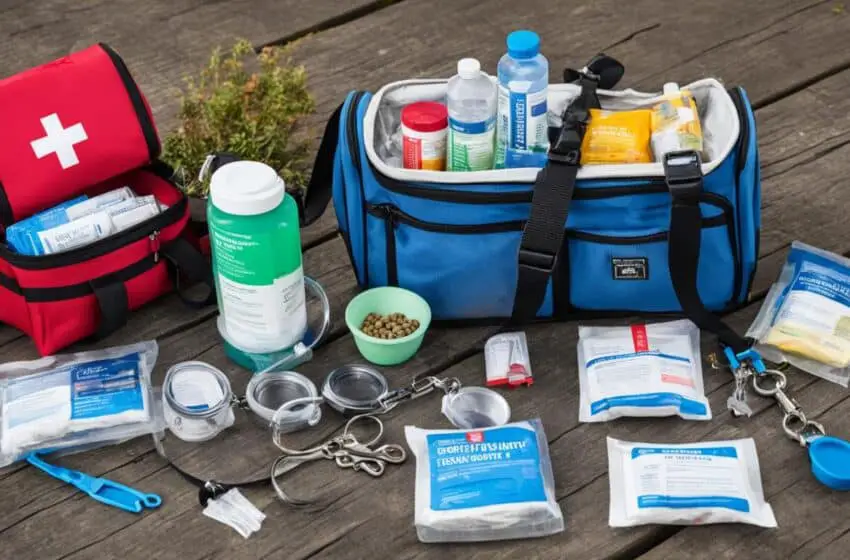Emergency Preparedness Tips for Small Pet Owners

As a small pet owner, I understand the importance of being prepared for emergencies to ensure the safety and well-being of our furry friends. Unexpected situations can arise at any time, and it is our responsibility to be ready to protect our small pets.
Emergency preparedness involves taking proactive steps to mitigate risks and have a plan in place to navigate difficult situations. By staying informed and prepared, we can provide the necessary care and support our small pets need during emergencies.
In this article, I will share essential tips to help you prepare for emergencies and keep your small pet safe in unexpected situations.
Key Takeaways:
- Emergency preparedness is crucial for the safety of small pets.
- Being informed and having a plan in place is essential.
- Proper identification and records are important for emergencies.
- Understanding your pet’s behavior and needs is essential for providing appropriate care.
- Pet-proofing your home reduces potential hazards.
Now, let’s dive into the details of how you can effectively prepare for emergencies and ensure the safety of your small pets.
Create an Emergency Kit for Your Small Pet
As a responsible small pet owner, it’s crucial to be prepared for unexpected situations, including emergencies. One of the most important steps you can take to protect your furry friend is to create an emergency kit specifically tailored for them.
An emergency kit for your small pet should include all the essentials they will need to survive and stay comfortable during a crisis. Here are the supplies that should be included:
- Food: Pack enough pet food to last for at least three to five days, stored in airtight containers to maintain freshness. If your pet has any dietary restrictions or special needs, make sure to include their specific food.
- Water: Include sufficient water for your pet, considering their hydration needs. It’s recommended to have one gallon of water per pet per day. Remember to store water in a safe and reusable container.
- Medication: If your small pet requires regular medication, ensure you have a sufficient supply of their medications in your emergency kit. Keep medications in a cool and dry place to maintain their effectiveness.
- First aid supplies: Accidents can happen even during emergencies, so it’s important to have basic first aid supplies in your kit. Include items such as bandages, antiseptic solution, tweezers, and any other items recommended by your veterinarian.
- Comforting items: In stressful situations, small pets often find comfort in familiar items. Pack a favorite toy or blanket that smells like home to help reduce their anxiety.
By having an emergency kit readily available, you’ll be able to provide for your small pet’s immediate needs in the event of an emergency. Remember to routinely check and update the contents of the kit to ensure everything remains fresh and up to date.
Develop an Evacuation Plan
When it comes to the safety of your small pet during emergencies, having a well-thought-out evacuation plan is of utmost importance. In the event of a disaster or any unforeseen circumstances, it’s essential to have a clear strategy in place to ensure both you and your furry companion can reach a safe location. Here are some key steps to help you develop an effective evacuation plan:
- Research Pet-Friendly Locations: Identify pet-friendly hotels, shelters, or boarding facilities in your area that allow small pets. Prioritize places that are easily accessible and have a reputation for accommodating pets during emergencies.
- Prepare a Pet Emergency Kit: As mentioned in the previous section, it’s crucial to have an emergency kit specifically designed for your small pet. Include essential supplies such as food, water, medications, a leash, and any comfort items that can help reduce stress. Keep this kit easily accessible and ready to go at a moment’s notice.
- Create a Communication Plan: Establish a reliable communication system with family members, neighbors, or friends who can assist you during an emergency. Share your evacuation plan with them and ensure they are aware of your small pet’s presence and needs.
- Practice Evacuation Drills: Regularly conduct evacuation drills with your small pet to familiarize them with the process. This will help reduce their anxiety and increase their cooperation during actual emergencies. Make the drills as realistic as possible, including packing the emergency kit and transporting your pet to a safe location.
Remember, time is of the essence during emergencies, so having a clearly defined evacuation plan can help streamline the process and increase the chances of reaching a safe location swiftly. By taking these proactive measures, you can ensure the safety and well-being of your small pet in times of crisis.
ID Your Pet and Keep Records Handy
Proper identification is crucial for the safety of your small pet, especially in the event of an emergency. By ensuring your pet is easily identifiable, you increase the chances of a swift reunion if they were to go missing.
One of the most effective ways to identify your pet is through the use of a microchip. A microchip is a tiny device, about the size of a grain of rice, that is implanted under your pet’s skin. It contains a unique identification number that can be scanned by a veterinarian or animal shelter. This permanent form of identification helps prevent the loss of your pet’s valuable information, such as their name and contact details. In the unfortunate event that your pet gets lost, a microchip greatly increases the chances of them being returned to you.
Alongside a microchip, it’s also essential to have a collar tag that includes your contact information. This serves as a visual identification tool and enables anyone who finds your pet to easily reach out to you. Make sure that the collar fits securely but not too tightly, and regularly check that the tag is still visible and readable.
“Having both a microchip and a collar tag provides a double layer of protection for your furry friend, ensuring that they can be identified even if one form of identification is lost or damaged,” says Dr. Emily Foster, a veterinarian with over 10 years of experience in pet care.
When it comes to emergencies, having quick access to your pet’s records is crucial. Keep important documents such as medical records, vaccination certificates, and any relevant permits or licenses in a safe and easily accessible place. This way, in the event of an emergency or if your pet requires immediate medical attention, you can provide all the necessary information without delay.
Remember, emergencies can be highly stressful for both you and your pet. Having proper identification and readily available records will help ensure their safety and provide you with peace of mind during challenging times.
| Essential Records | Description |
|---|---|
| Medical records | Include details of past illnesses, treatments, and any medications your pet may be taking. |
| Vaccination certificates | Keep copies of all vaccination records to ensure your pet is up-to-date on their immunizations. |
| Identification documents | Include proof of ownership, microchip paperwork, and any registration or license documents. |
Know Your Pet’s Behavior and Special Needs
Understanding your small pet’s behavior is vital in ensuring their well-being, especially during emergencies. Each pet has unique needs and characteristics that require special attention. By familiarizing yourself with their behavior and any special needs they may have, you can provide appropriate care when it matters most.
Observing Pet Behavior
Take the time to observe and interact with your small pet regularly. Pay attention to their body language, vocalizations, and habits. This will help you recognize any changes or signs of distress that may indicate your pet is unwell or experiencing discomfort.
- Observe their eating and drinking habits. Changes in appetite or water intake could be indicative of underlying medical conditions.
- Take note of their energy levels. Unusual lethargy or hyperactivity may signal an issue that requires attention.
- Monitor their bathroom habits. Sudden changes in urination or bowel movements could be a sign of illness.
- Watch for any unusual scratching, itching, or excessive grooming, as these may indicate skin allergies or irritations.
Special Needs and Medical Conditions
Some small pets may have specific needs or medical conditions that require extra care. It’s important to be aware of these and have the necessary medications or supplies readily available.
“Our guinea pig, Daisy, has a heart condition that requires daily medication. Knowing this allows us to be prepared in case of emergency and ensure her health is prioritized.” – Pet Owner, Jane Smith
If your pet has a known medical condition, consult with a veterinarian to create an emergency plan that addresses their specific needs. Keep any necessary medications, detailed instructions, and relevant veterinary contact information easily accessible.
Providing Comfort and Security
In times of stress or emergencies, small pets may require extra comfort and security to help alleviate anxiety. Familiar objects, such as their favorite toys or blankets, can provide reassurance and help them feel safe. Creating a calm and quiet environment can also have a soothing effect on your pet.
Remember, understanding your small pet’s behavior and special needs is essential for their overall well-being. By being prepared and attentive, you can provide the best care possible, even in challenging situations.
Create a Safe Environment at Home
Ensuring a safe environment for your small pet is paramount to their well-being. Pet-proofing your home helps minimize potential hazards and keeps your furry friend safe from harm. Here are some essential steps to create a safe environment:
Secure Loose Wires and Cords
Loose wires and cords pose a significant risk to your small pet. They may chew on them, leading to electric shock or injuries. Keep all wires and cords out of your pet’s reach by securing them with cord covers or routing them through inaccessible areas.
Store Chemicals Safely
Chemicals such as cleaning supplies, pesticides, and certain houseplants can be toxic to your small pet if ingested. Store these items in locked cabinets or high shelves to prevent accidental access. Choose pet-friendly alternatives for cleaning products whenever possible.
Identify and Remove Hazards
Thoroughly inspect your home for potential hazards that can harm your small pet. Some common hazards include sharp objects, small choking hazards, and toxic substances. Remove or securely store these items to prevent accidents.
Create a Pet-Safe Area
Designate a safe area in your home where your small pet can stay during emergencies. This area should be free from potential dangers and equipped with essential supplies. Ensure your pet has access to food, water, and shelter. Consider using pet gates or pens to restrict their access to hazardous areas.
Keep Toxic Plants Out of Reach
Plants like lilies, azaleas, and daffodils can be toxic to small pets if ingested. Keep these and any other toxic plants out of your pet’s reach or consider replacing them with pet-safe alternatives. Check the ASPCA’s list of toxic plants for reference.
By following these pet-proofing measures, you can create a safe environment at home for your small pet, reducing the risk of accidents and ensuring their well-being.
Conclusion
Emergency preparedness is a crucial aspect of keeping your small pets safe and ensuring their well-being. By following the tips outlined in this article, you can have peace of mind knowing that you are fully prepared to handle unexpected situations.
Remember, your small pet relies on you for their care and protection, so taking the necessary steps to be prepared should be a top priority. Having an emergency kit specifically tailored for your small pet, developing an evacuation plan, and properly identifying your pet are all essential for their safety.
Understanding your pet’s behavior and special needs, as well as creating a safe environment at home, can also contribute to their overall safety and well-being. Minimizing potential hazards and providing a designated safe area during emergencies is crucial.
By being proactive and prepared, you can ensure the safety and peace of mind of your small pets in the face of unexpected situations. Take action today and implement these tips to ensure that you are ready to handle any emergency that may arise.
FAQ
What should I include in an emergency kit for my small pet?
Your emergency kit should include essentials such as food, water, medication, and first aid supplies. Don’t forget to pack comforting items like blankets and toys to help reduce stress.
How do I create a detailed evacuation plan for my small pet?
To create an evacuation plan, identify a safe location to take your small pet in the event of an emergency. Research pet-friendly hotels or shelters in your area and have the necessary supplies ready for transportation.
How can I ensure that my small pet is properly identified?
Make sure your small pet is properly identified with a microchip and collar tag that includes your contact information. Additionally, keep important records such as medical records and vaccination certificates easily accessible in case of an emergency.
Is it important to understand my small pet’s behavior and special needs?
Yes, understanding your small pet’s behavior and any special needs they may have is crucial. Be aware of any medical conditions and have necessary medications or supplies readily available to provide appropriate care during emergencies.
How can I create a safe environment for my small pet at home?
Pet-proof your home by securing loose wires, chemicals, and toxic plants. Have a designated safe area where your small pet can stay during emergencies, and ensure they have access to food, water, and shelter.





